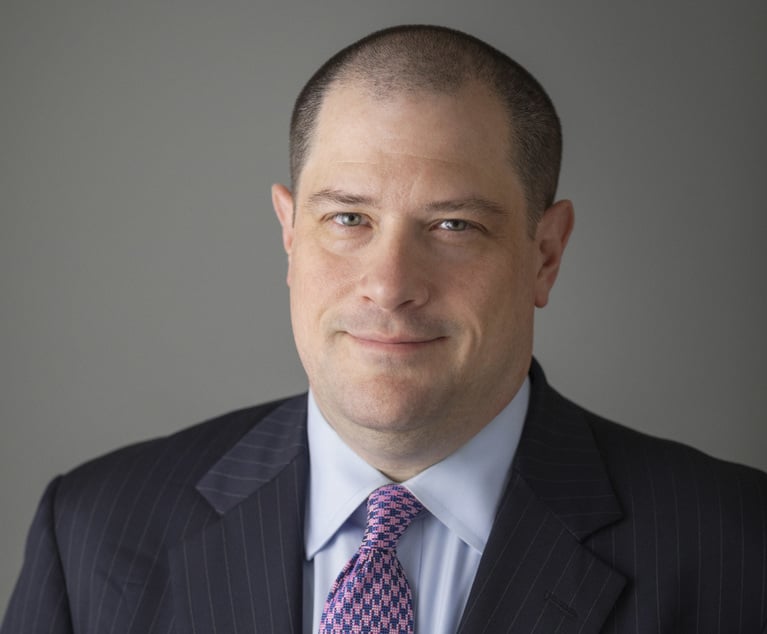 U.S. Supreme Court building in Washington, D.C.
U.S. Supreme Court building in Washington, D.C.Why History Supports US Supreme Court Term Limits
A high court comprising men and women who serve for a time and of a time, and not for all time like an English monarch, would be a welcome change to our democracy.
October 04, 2019 at 07:11 PM
5 minute read
Mitch McConnell blocked Merrick Garland, Donald Trump upset Hillary Clinton, and Brett Kavanaugh was confirmed to the U.S. Supreme Court. Now there are more than 20 Democrats running for president and ideas for reforming the court—specifically by adding justices or reducing their tenure length—have emerged as an increasingly popular topics on the campaign trail.
This is the first time since President Franklin Roosevelt's 1937 court-packing plan that we're debating reform, right? Far from it. A closer look at our history shows that plans to modify the court have been a part of our public discourse for centuries.
Limiting terms for Supreme Court justices is one modification currently being discussed. Historically, those opposed to this change have argued that the founders provided life tenure for a reason. This is undoubtedly true. It's also true that proposals to end life tenure began with the Founding Fathers themselves. As Thomas Jefferson wrote in an 1820 letter, "To consider the judges as the ultimate arbiters of all constitutional questions [is] a very dangerous doctrine indeed and one which would place us under the despotism of an oligarchy." Two years later he added: "We have erred in this point, by copying England."
Our third president wasn't alone in his disapproval. Legislative efforts to limit the tenure of federal judges began almost immediately after the judiciary was organized by Congress in 1789. According to a widely cited article by Michael J. Mazza, a former federal law clerk and law professor, three more proposals were introduced in the 1830s, six in the 1860s and 1870s, and then more than 20 between 1890 and 1933, when Roosevelt began his first term.
Talk on the trail this year of one plan in particular, court-packing, has naturally led to reconsidering Roosevelt's effort to add justices. Lost in much of our retelling of Roosevelt's plan is that it was derived from ideas already percolating in Congress and not something a frustrated president concocted out of whole cloth.
Congressional records and contemporary news articles demonstrate there was concern in the early 20th century over the power of the judiciary. Three constitutional amendments were introduced in the Senate shortly after Roosevelt announced his statutory plan to add justices. Two were for mandatory retirement (one at 70, the other at 75), and the third limited tenure to nine years. In short order, a series of variations on these amendments were put forward, though they were stymied by lack of support from a White House pushing its own proposal.
In 1954 a conservative Republican senator introduced a plan to end life tenure through a mandatory retirement age of 75. A resolution on it passed 58-19 in the Senate, winning the votes of then-Sens. John F. Kennedy and Lyndon Johnson.
Ending life tenure at the Supreme Court has even received support among its members. Justice Byron White's service overlapped with the end of Justice William Douglas' tenure—a stint marred by Douglas' increasing infirmities. Weeks before Douglas' 1975 retirement, White wrote, "I am convinced that it would have been better had retirement been required at a specified age by the Constitution," and that "a constitutional amendment to that effect should be proposed and adopted." Added a 79-year-old Justice Lewis Powell upon his retirement a few years later: "It would have been wise for the Founding Fathers to have required retirement of federal judges at a specified age, perhaps at 75."
In the 1980s and 1990s more than 20 proposals aimed at limiting Supreme Court tenure were introduced in Congress. And though it's now been two decades since a serious congressional effort has been undertaken, much of the 2016 Republican presidential field was firmly on board with ending life tenure at the high court.
There is a reflexive appeal in assuming our institutions are the way they are today because other people, smarter people, people who came before us, banded together and agreed that this is how things should be. It may seem less comforting to consider that some of these institutions' fundamental characteristics—even at the venerable Supreme Court—have come about in spite of significant and constant opposition.
In a democracy, this opposition is never more than a few flashpoints or a few votes away from a breakthrough. Americans today should look to rectify what Jefferson pointed out almost 200 years ago when he called life-tenured justices "a solecism in a republic, of the first order of absurdity and inconsistency."
A high court comprising men and women who serve for a time and of a time, and not for all time like an English monarch, would be a welcome change to our democracy. Jefferson and many other leaders of nation's past would likely agree. And as they might've said to one another as they discussed founding a new nation, change isn't always a bad thing.
Tyler Cooper is senior researcher at Fix the Court, a nonpartisan organization focused on increasing transparency and accountability at the U.S. Supreme Court. He obtained a J.D. from Boston College, and has worked previously on Capitol Hill and to protect voting rights.
This content has been archived. It is available through our partners, LexisNexis® and Bloomberg Law.
To view this content, please continue to their sites.
Not a Lexis Subscriber?
Subscribe Now
Not a Bloomberg Law Subscriber?
Subscribe Now
NOT FOR REPRINT
© 2024 ALM Global, LLC, All Rights Reserved. Request academic re-use from www.copyright.com. All other uses, submit a request to [email protected]. For more information visit Asset & Logo Licensing.
You Might Like
View All
Protecting Attorney-Client Privilege in the Modern Age of Communications
6 minute read

Lingering Questions at Supreme Court About Climate Change Litigation Need Resolution
6 minute read
Trending Stories
- 1Cars Reach Record Fuel Economy but Largely Fail to Meet Biden's EPA Standard, Agency Says
- 2How Cybercriminals Exploit Law Firms’ Holiday Vulnerabilities
- 3DOJ Asks 5th Circuit to Publish Opinion Upholding Gun Ban for Felon
- 4GEO Group Sued Over 2 Wrongful Deaths
- 5Revenue Up at Homegrown Texas Firms Through Q3, Though Demand Slipped Slightly
Who Got The Work
Michael G. Bongiorno, Andrew Scott Dulberg and Elizabeth E. Driscoll from Wilmer Cutler Pickering Hale and Dorr have stepped in to represent Symbotic Inc., an A.I.-enabled technology platform that focuses on increasing supply chain efficiency, and other defendants in a pending shareholder derivative lawsuit. The case, filed Oct. 2 in Massachusetts District Court by the Brown Law Firm on behalf of Stephen Austen, accuses certain officers and directors of misleading investors in regard to Symbotic's potential for margin growth by failing to disclose that the company was not equipped to timely deploy its systems or manage expenses through project delays. The case, assigned to U.S. District Judge Nathaniel M. Gorton, is 1:24-cv-12522, Austen v. Cohen et al.
Who Got The Work
Edmund Polubinski and Marie Killmond of Davis Polk & Wardwell have entered appearances for data platform software development company MongoDB and other defendants in a pending shareholder derivative lawsuit. The action, filed Oct. 7 in New York Southern District Court by the Brown Law Firm, accuses the company's directors and/or officers of falsely expressing confidence in the company’s restructuring of its sales incentive plan and downplaying the severity of decreases in its upfront commitments. The case is 1:24-cv-07594, Roy v. Ittycheria et al.
Who Got The Work
Amy O. Bruchs and Kurt F. Ellison of Michael Best & Friedrich have entered appearances for Epic Systems Corp. in a pending employment discrimination lawsuit. The suit was filed Sept. 7 in Wisconsin Western District Court by Levine Eisberner LLC and Siri & Glimstad on behalf of a project manager who claims that he was wrongfully terminated after applying for a religious exemption to the defendant's COVID-19 vaccine mandate. The case, assigned to U.S. Magistrate Judge Anita Marie Boor, is 3:24-cv-00630, Secker, Nathan v. Epic Systems Corporation.
Who Got The Work
David X. Sullivan, Thomas J. Finn and Gregory A. Hall from McCarter & English have entered appearances for Sunrun Installation Services in a pending civil rights lawsuit. The complaint was filed Sept. 4 in Connecticut District Court by attorney Robert M. Berke on behalf of former employee George Edward Steins, who was arrested and charged with employing an unregistered home improvement salesperson. The complaint alleges that had Sunrun informed the Connecticut Department of Consumer Protection that the plaintiff's employment had ended in 2017 and that he no longer held Sunrun's home improvement contractor license, he would not have been hit with charges, which were dismissed in May 2024. The case, assigned to U.S. District Judge Jeffrey A. Meyer, is 3:24-cv-01423, Steins v. Sunrun, Inc. et al.
Who Got The Work
Greenberg Traurig shareholder Joshua L. Raskin has entered an appearance for boohoo.com UK Ltd. in a pending patent infringement lawsuit. The suit, filed Sept. 3 in Texas Eastern District Court by Rozier Hardt McDonough on behalf of Alto Dynamics, asserts five patents related to an online shopping platform. The case, assigned to U.S. District Judge Rodney Gilstrap, is 2:24-cv-00719, Alto Dynamics, LLC v. boohoo.com UK Limited.
Featured Firms
Law Offices of Gary Martin Hays & Associates, P.C.
(470) 294-1674
Law Offices of Mark E. Salomone
(857) 444-6468
Smith & Hassler
(713) 739-1250








